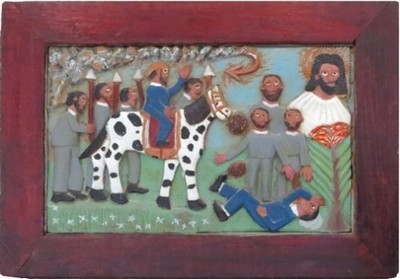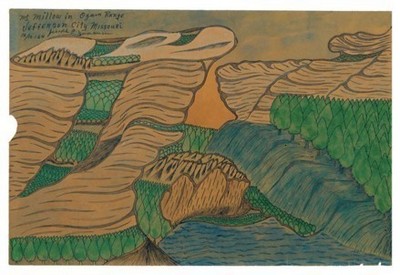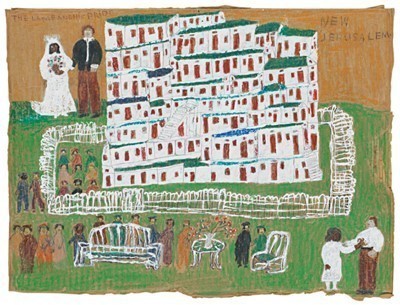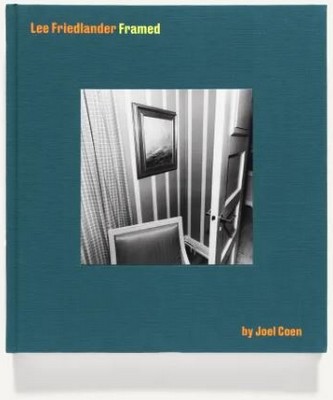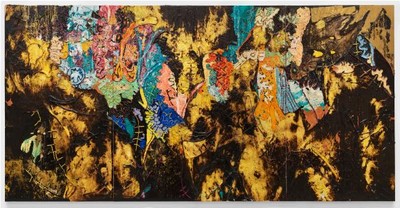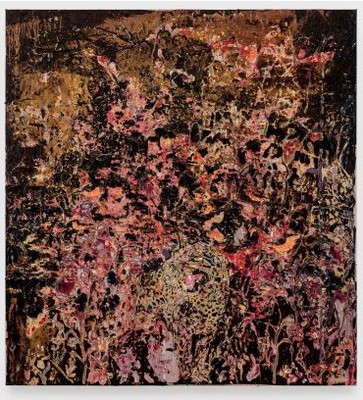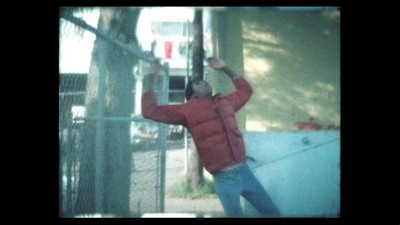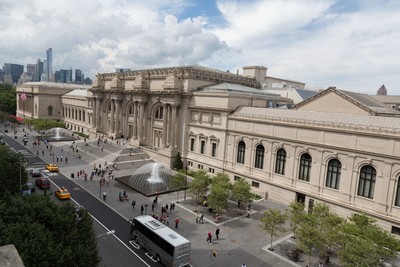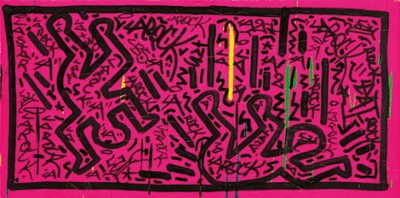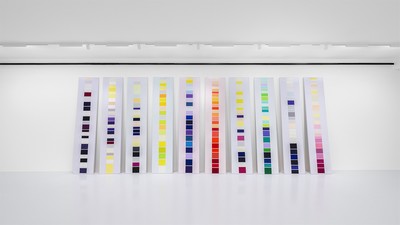Of God and Country:
American Art from the Jill and Sheldon Bonovitz Collection
Philadelphia Museum of Art
May 19, 2023 – January 1, 2024
Cotton Kingdom,1987
Paint and enamel on carved wood
Collection of Jill and Sheldon Bonovitz
The Philadelphia Museum of Art is presenting an exhibition devoted to an important group of works by artists historically marginalized or excluded from traditional narratives of art history and typically described as “Outsider artists.” Of God and Country: American Art from the Jill and Sheldon Bonovitz Collection explores their work through themes ranging from history to daily life, including the nation’s legacy of enslavement and racism, the landscape, and meditations on death and mortality. The exhibition features voices that variously critique and celebrate American life, often expressing ambivalence toward both the past and present while strong faith in the future, whether in this life or the next. Each work is drawn from the Jill and Sheldon Bonovitz Collection, including gifts, promised gifts, and loans to the museum.
Sasha Suda, the George D. Widener Director and CEO, said: “Surrender your ideas of genre as you enter Of God and Country and allow yourself to let codified art hierarchies and categories melt away. That is the special pleasure of this collection of work often called Outsider Art. We are immensely grateful to Jill Bonovitz, and to our longstanding museum Trustee Sheldon Bonovitz, for this remarkable array of works. Not only did they generously present the museum with a major promised gift of their collection in 2011, but the Bonovitzes have continued to collect with insight and passion and have generously contributed additional gifts during their shared adventure.”
Many of the artists represented in the exhibition ultimately achieved considerable reputations. Martín Ramírez and Bill Traylor are considered iconic figures. Sister Gertrude Morgan, Rev. Howard Finster, Joseph Yoakum, and Purvis Young are also widely known, while others remain less well recognized practitioners in the field of 20th century American art, including Jon Serl, Bruno del Favero, and S.L. Jones.
Untitled (Truck & Protesters), Late 20th century
Mixed media, paint on wood construction
Collection of Jill and Sheldon Bonovitz
The exhibition includes a broad range of media, sizes, and styles, and is organized in four sections, beginning with U.S. History & Life in America, which contains potent symbols of the US, including the flag, Uncle Sam, and portraits of figures ranging from Abraham Lincoln and Dwight D. Eisenhower to Rev. Martin Luther King, Jr. Some works highlight positive aspects of American life while others, such as Jail was Heat, by Purvis Young (1943-2010) and The Enemies Within, by Herbert Singleton (1945-2007), contain themes of discriminatory policing and incarceration policies that target Black communities.
Mt Willow in Ozark Range, Jefferson City Missouri,
Early to mid-20th century
Watercolor, pen, and ink on paper
Collection of Jill and Sheldon Bonovitz
A section called The American Landscape contains lively images of people and animals, agrarian life, and mountain ranges. Many of the artists represented here grew up in rural communities, often working on farms, while others traveled widely. Works by Martin Ramirez (1895-1963) include Horse and Rider, which evokes mineshafts and tunnels that the artist would have known working as a miner and railroad worker in California. Another drawing, by Joseph Yoakum (1891-1972), evokes dreamy mountains, rivers, gorges, and rocky outcroppings, suggesting an anthropomorphic vision infused by memory and imagination.
The Lamb and his Bride, 20th century
Ink, acrylic, and crayon on repurposed Tide laundry detergent box
Collection of Jill and Sheldon Bonovitz
Christianity and Spirituality reflects a history of American evangelicalism, as these artists often felt divinely inspired to make art and used their work to teach religious devotion. The section contains a focused grouping of works by street preacher Sister Gertrude Morgan (1900-1980), who established a gospel mission in the lower ninth ward of New Orleans. She represented herself as the bride of Christ there in New Jerusalem Highway, a painting also populated with images of angels.
People and Time Come Together . . ., #16,977, 1990
Paint on wood cutout
Collection of Jill and Sheldon Bonovitz
Death and Mortality, the final section, reflects upon life’s fragility and Christian afterlife. In People and Time Come Together, Rev. Howard Finster (1916-2001) offers us a scaly dinosaur, painted on wood, surrounded by warnings of apocalypse; he dedicated himself to art at age 60, following a vision, and produced thousands of works, often evoking the urgency of end times. Another highlight is St. Helena First Black Embalmer John, painted on a corrugated iron sheet by Sam Doyle (1906-1985). He often rendered Black celebrities, such as Ray Charles or Joe Louis, but here focuses on a man practicing his craft as an embalmer, readying the deceased for the next journey.
The exhibition is organized by Louis Marchesano, Audrey and William H. Helfand Senior Curator of Prints, Drawings, and Photographs; Jessica Smith, Director of Curatorial Initiatives and Susan Gray Detweiler Curator of American Art; Jun P. Nakamura, former Suzanne Andree Curatorial Fellow; with contributions from Monique D'Almeida, Margaret R. Mainwaring Curatorial Fellow and Kendra Grimmett, former Carl Zigrosser Fellow.
“This exhibition is devoted to works created by people who operated far from the world of galleries, museums, and art schools, and yet they created astonishing works of art," said Louis Marchesano. “Of God and Country argues for a much wider, open-ended and more inclusive consideration of artistic vision in the United States of the 20th century and today.”
This exhibition is made possible by Jill and Sheldon Bonovitz.
About the Jill and Sheldon Bonovitz Collection
It is considered one of the finest private collections of works by American self-taught artists, and Jill and Sheldon Bonovitz assembled it over the course of several decades before making part of it a promised gift to the Philadelphia Museum of Art in 2011. Including 177 works of art, it contributed significantly to establishing the Museum as one of the primary centers for the study of artists who once rarely found a place in American museums, many having operated without academic training and outside traditional artistic discourse. The works in the Bonovitz collection were often produced in remote places using unconventional methods and materials such as reclaimed wood, sheet metal, house paint, and stove soot. These works draw upon the artists’ own experiences, immediate surroundings, and popular culture. In 2013, in association with Yale University Press, the Philadelphia Museum of Art published Great and Mighty Things: Outsider Art from the Jill and Sheldon Bonovitz Collection, on the occasion of a major exhibition of the same title.
PHILADELPHIA MUSEUM OF ART
2600 Benjamin Franklin Parkway, Philadelphia, PA 19130



